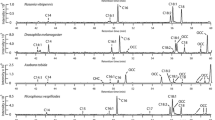Abstract
Species from Diptera (Hermetia illucens and Lucilia sericata), Coleoptera (Tenebrio molitor and Zophoba morio) and Orthoptera (Locusta migratoria, Acheta domestica and Anacridium aegyptium) were analyzed for fatty acid profiles and cholesterol content. The following solvent systems were tested for extraction: direct methylation (CH3OH/CH3COCl/hexane); n-hexane; acetone; ethanol/water; hexane/ethanol; and direct saponification (KOH and ethanol). Direct methylation was performed as control of extraction yields and to evaluate the possible use of these fats as biodiesel. Insect lipids were extracted by ethanol in a similar extent as did other tested organic solvents, while direct methylation of the biomass provided the highest yields. L. sericata and Z. morio contained high percentages of monounsaturated fatty acids; A. aegyptium and L. migratoria were two polyunsaturated fatty acid-enriched species, while H. illucens and Z. morio showed high proportions of medium-chain fatty acids. All extracted fats might be used in the alimentary industry, as evidenced by their low cholesterol content, as well as for biodiesel obtainment, as suggested by computed saponification, iodine and cetane values. Samples of H. illucens and L. migratoria showed exceptional cetane numbers (64.8 and 60.7, respectively), and all tested species except A. aegyptium exhibited an exceptional fatty acid profile for biodiesel production.

Similar content being viewed by others
References
Barroso FG, de Haro C, Sánchez-Muros MJ, Venegas E, Martínez-Sánchez A, Pérez-Bañón C (2014) The potential of various insect species for use as food for fish. Aquaculture 422:193–201
Ramos-Elorduy J (1997) Insects: a sustainable source of food? Ecol Food Nutr 36:247–276
Manzano-Agugliaro F, Sanchez-Muros MJ, Barroso FG, Martínez-Sánchez A, Rojo S, Pérez-Bañón C (2012) Insects for biodiesel production. Renew Sust Energ Rev 16:3744–3753
Zompa-Sosa DA, Yi L, van Valenberg HJ, van Boekel MA, Lakemond CM (2014) Insect lipid profile: aqueous vs organic solvent-based extraction methods. Food Res Int 62:1087–1094
Zheng L, Li Q, Zhang J, Yu Z (2012) Double the biodiesel yield: rearing black soldier fly larvae, Hermetia illucens, on solid residual fraction of restaurant waste after grease extraction for biodiesel production. Renew Energ 41:75–79
Zheng L, Hou Y, Li W, Yang S, Li Q, Yu Z (2013) Exploring the potential of grease from yellow mealworm beetle (Tenebrio molitor) as a novel biodiesel feedstock. Appl Energ 101:618–621
Leung D, Yang D, Li Z, Zhao Z, Chen J, Zhu L (2012) Biodiesel from Zophobas morio larva oil: process optimization and FAME characterization. Ind Eng Chem Res 51:1036–1040
Rincón-Cervera MA, Venegas-Venegas E, Ramos-Bueno RP, Suárez-Medina MD, Guil-Guerrero JL (2015) Docosahexaenoic acid purification from fish processing industry by-products. Eur J Lipid Sci Technol 117:724–729
Kalayasiri P, Jayashke N, Krisnangkura K (1996) Survey of seed oils for use as diesel fuels. J Am Oil Chem Soc 73:471–474
Krisnangkura K (1986) A simple method for estimation of Cetane index of vegetable oil methyl esters. J Am Oil Chem Soc 63:552–553
Zompa-Sosa DA, Yi L, van Valenberg HJ, van Boekel MA, Lakemond CM (2014) Insect lipid profile: aqueous vs organic solvent-based extraction methods. Food Res Int 62:1087–1094
Molina-Grima E, Ibáñez-González MJ, Giménez-Giménez A (2013) In: Borowitzka MA, Moheimani NR (eds) Algae for biofuels and energy. Springer, Dordrecht
Torres LG, Velasquez A, Brito-Arias MA (2011) Ca-alginate spheres behavior in presence of some solvents and water-solvent mixtures. Adv Biosci Biotechnol 2:8
Sawangkeaw R, Ngamprasertsith S (2013) A review of lipid-based biomasses as feedstocks for biofuels production. Renew Sust Energy Rev 25:97–108
Negussie A, Achten WMJ, Norgrove L, Hermy M, Muys B (2013) Invasiveness risk of biofuel crops using Jatropha curcas L. as a model species. Biofuels, Bioprod Biorefin 5(7):485–498
Pinzi S, Leiva-Candia D, López- García I, Redel- Macías MD, Dorado MP (2014) Latest trends in feedstocks for biodiesel production. Biofuels. Bioprod Biorefin 8:126–143
Azam M, Waris A, Nahar NM (2005) Prospects and potential of fatty acid methyl esters of some non-traditional seed oils for use as biodiesel in India. Biomass Bioenergy 29:293–302
Wieselburg BLT (2004) Review on biodiesel standardization world-wide. Graz, IEA Bioenergy Task 39, Subtask “Biodiesel”
Ganem-Quintanar A, Quintanar-Guerrero D, Buri P (2000) Monoolein: a review of the pharmaceutical applications. Drug Dev Ind Pharm 26:809–820
Adeyeye EI (2013) Domestic pig organs as good sources of nutritionally important fatty acids and low cholesterol meat. Global J Sci Front Res 13:1
Guil-Guerrero JL (2007) Stearidonic acid (18:4n-3): metabolism, nutritional importance, medical uses and natural sources. Eur J Lipid Sci Technol 109:1226–1236
Finke MD (2002) Complete nutrient composition of commercially raised invertebrates used as food for insectivores. Zoo Biol 21:269–285
Gopala Krishna AG, Gaurav R, Ajit Singh B, Prasanth Kumar PK (2010) Coconut oil: chemistry, production and its applications-a review. Indian Coconut J 53(3):15–27
Author information
Authors and Affiliations
Corresponding author
Ethics declarations
Compliance with ethics requirements
All procedures were conducted according to the guidelines of Council Directive 86/609/EEC (European Communities 1986) on the protection of animals used for experimental and other scientific purposes, and the study was approved by the Bioethical Committee for Animal Experiments at the University of Almería.
Conflict of interest
The authors declare that they have no conflict of interest.
Electronic supplementary material
Below is the link to the electronic supplementary material.
Rights and permissions
About this article
Cite this article
Ramos-Bueno, R.P., González-Fernández, M.J., Sánchez-Muros-Lozano, M.J. et al. Fatty acid profiles and cholesterol content of seven insect species assessed by several extraction systems. Eur Food Res Technol 242, 1471–1477 (2016). https://doi.org/10.1007/s00217-016-2647-7
Received:
Revised:
Accepted:
Published:
Issue Date:
DOI: https://doi.org/10.1007/s00217-016-2647-7




